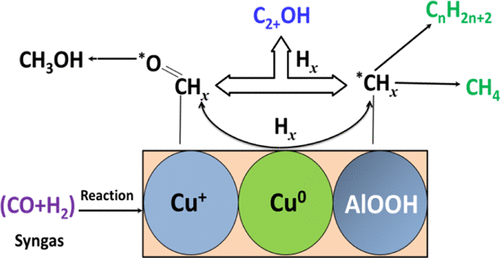当前位置:
X-MOL 学术
›
ACS Sustain. Chem. Eng.
›
论文详情
Our official English website, www.x-mol.net, welcomes your
feedback! (Note: you will need to create a separate account there.)
Synergy between Active Sites of Ternary CuZnAlOOH Catalysts in CO Hydrogenation to Ethanol and Higher Alcohols
ACS Sustainable Chemistry & Engineering ( IF 7.1 ) Pub Date : 2020-04-08 , DOI: 10.1021/acssuschemeng.9b07587 Yong-Jun Liu 1 , Nan Cui 1 , Peng-Long Jia 1 , Xu Wang 1 , Wei Huang 1, 2
ACS Sustainable Chemistry & Engineering ( IF 7.1 ) Pub Date : 2020-04-08 , DOI: 10.1021/acssuschemeng.9b07587 Yong-Jun Liu 1 , Nan Cui 1 , Peng-Long Jia 1 , Xu Wang 1 , Wei Huang 1, 2
Affiliation

|
Currently, the Cu-based catalyst has become a promising candidate for ethanol and higher alcohols synthesis (HAs) from synthesis gas (H2 + CO), but all these catalysts contain F–T elements (e.g., Co and Fe) and alkalis because carbon chain growth reaction occurs on these metal components. Herein, two series of ternary CuZnAlOOH catalysts with various Cu and Al proportions were synthesized using a complete liquid-phase method and studied in the conversion of syngas in a slurry bed reactor. Significantly higher selectivity of ethanol (40 wt %) and HA (65 wt %) with approximately 20% CO conversion was achieved when the n(Cu)/n(Al) = 2/0.8, which was ascribed the highest copper surface area (SCu) and the surface Cu content. It was found that the Cu component had a significant effect on CO conversion, while the Al component had more influence on the selectivity of HA. Besides, the coke deposition was discovered to be the main reason for catalyst deactivation. The generation of hydrocarbons and alcohols followed A–S–F distributions, which was consistent with a representative mechanism of HA generation by CO insertion into the CHx intermediate. A synergetic mechanism between Cu0–Cu+ and AlOOH active sites was proposed based on the characterization analysis and activity results, in which Cu0–Cu+ synergy acted as sites for H2 dissociative adsorption and associative adsorption of CO, while the AlOOH facilitated the dissociation of the C–O bond. Bifunctionality of the Cu and AlOOH active sites and their cooperation created their synergy in CO hydrogenation to ethanol and HA. This work provided us a new concept to understand and develop carbon chain growth mechanism, and it also could provide reference for other related carbon chain growth reactions.
中文翻译:

一氧化碳加氢制乙醇和高级醇中三元CuZnAlOOH催化剂活性位点之间的协同作用
目前,铜基催化剂已成为从合成气(H 2 + CO)进行乙醇和高级醇合成(HAs)的有前途的候选者,但是所有这些催化剂都包含F-T元素(例如Co和Fe)和碱,因为碳链增长反应发生在这些金属成分上。在此,使用完全液相法合成了具有不同铜和铝比例的两系列三价CuZnAlOOH催化剂,并研究了在浆床反应器中合成气的转化。当n (Cu) / n (Al) = 2 / 0.8(归因于最高的铜表面积(n ))时,乙醇(40 wt%)和HA(65 wt%)的选择性显着提高,CO转化率约为20%。小号铜)和表面铜含量。发现铜组分对CO转化有显着影响,而铝组分对HA的选择性具有更大的影响。此外,发现焦炭沉积是催化剂失活的主要原因。碳氢化合物和醇的生成遵循A–S–F分布,这与通过将CO插入CH x中间体而生成HA的代表性机制相一致。根据表征分析和活性结果,提出了Cu 0 -Cu +与AlOOH活性位点之间的协同机制,其中Cu 0 -Cu +协同作用为H 2的位点。CO的解离吸附和缔合吸附,而AlOOH促进C–O键的解离。Cu和AlOOH活性位点的双功能性以及它们的合作在CO加氢成乙醇和HA方面产生了协同作用。这项工作为我们理解和发展碳链增长机理提供了新的思路,也可以为其他相关的碳链增长反应提供参考。
更新日期:2020-04-08
中文翻译:

一氧化碳加氢制乙醇和高级醇中三元CuZnAlOOH催化剂活性位点之间的协同作用
目前,铜基催化剂已成为从合成气(H 2 + CO)进行乙醇和高级醇合成(HAs)的有前途的候选者,但是所有这些催化剂都包含F-T元素(例如Co和Fe)和碱,因为碳链增长反应发生在这些金属成分上。在此,使用完全液相法合成了具有不同铜和铝比例的两系列三价CuZnAlOOH催化剂,并研究了在浆床反应器中合成气的转化。当n (Cu) / n (Al) = 2 / 0.8(归因于最高的铜表面积(n ))时,乙醇(40 wt%)和HA(65 wt%)的选择性显着提高,CO转化率约为20%。小号铜)和表面铜含量。发现铜组分对CO转化有显着影响,而铝组分对HA的选择性具有更大的影响。此外,发现焦炭沉积是催化剂失活的主要原因。碳氢化合物和醇的生成遵循A–S–F分布,这与通过将CO插入CH x中间体而生成HA的代表性机制相一致。根据表征分析和活性结果,提出了Cu 0 -Cu +与AlOOH活性位点之间的协同机制,其中Cu 0 -Cu +协同作用为H 2的位点。CO的解离吸附和缔合吸附,而AlOOH促进C–O键的解离。Cu和AlOOH活性位点的双功能性以及它们的合作在CO加氢成乙醇和HA方面产生了协同作用。这项工作为我们理解和发展碳链增长机理提供了新的思路,也可以为其他相关的碳链增长反应提供参考。









































 京公网安备 11010802027423号
京公网安备 11010802027423号